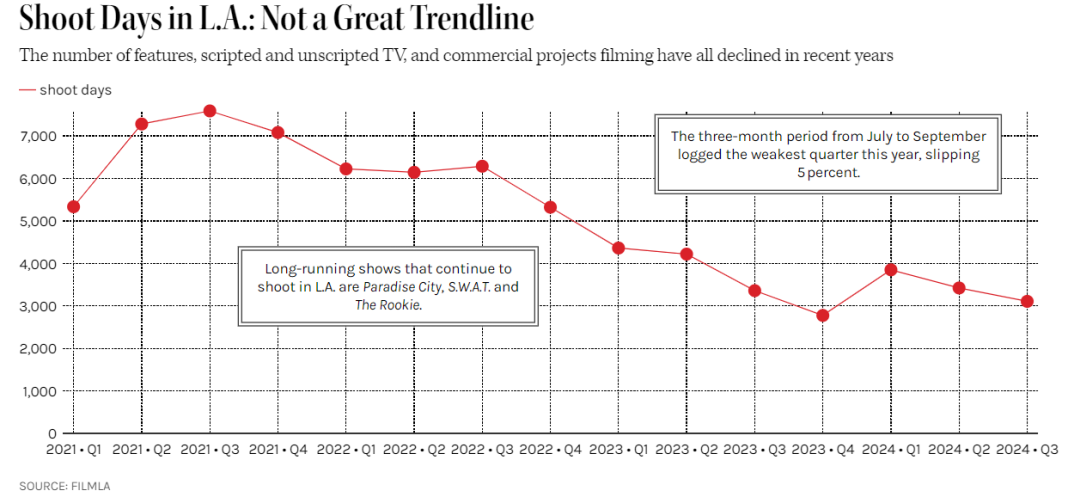As the number of movie and TV shoots approaches historic lows, insiders are lobbying for fewer restrictions to help bolster Hollywood’s place in the city it calls home.
For years, Gordon Ramsay and his hit MasterChef franchise called a converted soundstage in Los Angeles home. From there, contestants crisscrossed the 30-mile zone where Hollywood holds court to film on location at glitzy mansions and Michelin-starred restaurants. Tens of millions of dollars flowed into the economy across the Fox show’s 14 seasons.
Enter Australia, which has aggressively been courting the production to relocate. It was a tempting proposition. The burgeoning film hub, unlike California, allows unscripted programming to receive tax credits to shoot there. Still, the math didn’t make sense, at least not until permitting issues with MasterChef’s L.A. soundstage emerged that would require major renovations. So, starting next year, producers will fly dozens of home cooks — and the troves of cash that come with a big-budget network production — to shoot in Australia.
“It’s distressing,” says Paul Audley, president of the permitting office FilmLA. “We worked a lot to try to keep them here.”
The flight of production from L.A. started as a trickle. A television show relocating to Georgia here. A movie opting to film in the U.K. there. Now, the migration borders on an exodus. Since the strikes ended last year, Hollywood has been holding its breath for a comeback worthy of the more flush days of power lunches at the Polo Lounge. A clearer picture is coming into focus that the rebound has yet to materialize. New data released by FilmLA on Oct. 16 shows that filming in L.A. is approaching historically low levels, with the three-month period from July to September seeing the fewest number of shoot days this year. The figure even falls short of shooting in the region during the same time last year, when the industry was halted by the work stoppage.
What started as an expectation that Hollywood will rally after the strikes has become muted hope that things could get better within the next year. Production — alongside employment — is falling short of projections. Every category of filming for scripted content trails historical norms.
Part of the downturn of filming in the city can be traced to the contraction from the era of so-called Peak TV, when studios were viciously competing for subscribers to grow their streaming endeavors. But some data indicates that competing international film hubs are seeing flat, or in some cases rising, levels of production. Last quarter, the U.K. and Canada each saw more live-action, scripted titles with budgets of at least $10 million actively filming within their borders. The U.S., meanwhile, saw a 35 percent decline (251 to 163), according to industry intelligence platform ProdPro.
“To the extent production has pulled back, the vast majority of that is happening to U.S.-based projects,” says ProdPro chief executive Alex LoVerde, who notes that New York has proved more resilient (about 75 percent of 2022 production levels compared with about 60 percent in other states).
Other data suggests that L.A.’s share of the film and TV economy is shrinking, though it remains at the front of the pack. The region posted a 27 percent share of employment in the sector in 2023 — an indication of its portion of domestic production — compared with 35 percent just the year before, per an Otis College report. Californians now account for less than 30 percent of the business’ workers, down 10 percent from a decade ago, according to the U.S. Bureau of Labor Statistics.
Hollywood luminaries are taking notice, lobbying for more financial support while bemoaning sky-high filming costs. Speaking to The Hollywood Reporter at a fundraiser in September, Judd Apatow said that California will keep ceding productions to other states and countries if it doesn’t implement a “healthy tax rebate for our industry.”
“It is heartbreaking to watch it happen because as people tighten their belts, there are very few situations where people can just stay in town because they want to,” said the director, who has filmed more than half his movies in the state.
A production executive at a major studio stresses that “pressure on budgets is at the highest level that it’s been in 10 years.” Amid this financial austerity, he says there’s “been a lot more scrutiny” in considering alternative locations to ensure production tax credits are maximized. “We want to be getting as much return as we can,” the exec adds. “It’s rare we do a show without some question about the incentive aspect, not just in scripted, but all the way down to unscripted and documentaries now.”
The upshot: A production greenlight is tied to budgets increasingly taking every penny into account. On this front, California is behind the ball. The state’s film commission offers a 20 percent base credit to feature films and TV series — lower than most jurisdictions vying for Hollywood dollars, including New York, New Mexico and the U.K. — and has a $330 million cap on the program. It’s the only major production hub that bars any portion of above-the-line costs, like salaries for actors, directors and producers, from qualifying for incentives. The U.K. has leveraged that idiosyncrasy to lure big-budget titles. Of late, it’s become a premier destination for features. So has Canada, which has the added advantage of beneficial exchange rates.
And while L.A. has long retained a stranglehold in unscripted, its grip is quickly loosening. There was one-third the number of shoot days for reality TV last quarter compared to the highs of 2022. And it may not return to the region at the same levels as before the work stoppage. Other states and countries are making increasingly attractive bids for the likes of Selling Sunset, The Golden Bachelorette and 90 Day Fiancé. In June, Illinois Gov. JB Pritzker signed a bill expanding the state’s tax credit program to include game, talk and contest-based shows, among other types of reality TV. Georgia already allows the format to qualify.
The studio production exec notes that margins for unscripted programming are typically much lower, which has pushed productions to look abroad. “That’s just a natural part of looking for the best deals on the planet,” the exec says.
The production downturn has forced some industry insiders to reconcile with the impact of the most recent WGA and SAG-AFTRA deals, which structure yearly minimum raises to match inflation.
Preston Garrett, managing director of production company Rakish, is advocating for a moratorium on increases to crews and the temporary lowering of minimums until more work returns. “What matters more, keeping pace with what’s deemed to be fair inflation or sustainable crew rates that keep people working?” Garrett asks. “If we make the market more competitive, more work will come.”
On Monday, Sony Pictures Entertainment CEO Tony Vinciquerra warned that the deals made with major labor unions are suppressing domestic production. “The contract terms are forcing productions out of the U.S. now,” he said at MIPCOM in Cannes.
“There’s a very significant difference in California, which has been the hardest hit [and] just hasn’t responded to what’s going on in the world of incentives,” Vinciquerra noted. “The cost of doing business in California is so high that it’s very difficult to price out a film.”
In a statement, SAG-AFTRA national executive director Duncan Crabtree-Ireland said Vinciquerra is peddling a “false narrative.” He added, “Threatening the offshoring of American jobs is a cynical attempt to manipulate workers while masking the industry’s own business failures.”
Other Hollywood vets lament that L.A. is simply no longer a film-friendly hub. It’s not any one thing, it’s death by a thousand cuts. Another example: The rising cost of shooting permits. Last year, FilmLA rolled out rate hikes on a slew of fees. While some of the increases were tied to inflation, others represented markups of roughly 8 to 17 percent. Among the service pricing changes were additional limitations imposed by the guidelines that have aggravated location budgets. A permit that used to accommodate up to 10 locations over 14 consecutive days now allows for only five locations over seven days.
Jason McCauley, a location manager for Joker: Folie à Deux, which was partially filmed in L.A., says he’s seen permitting fees double in some cases. “It’s not the deciding factor, but those costs on top of what it otherwise costs to film here become expensive,” he adds. “It’s not just the permits; it’s labor, fuel, parking.”
Actor and producer Luke Barnett (Faith Based, Your Lucky Day) says he realized Los Angeles was in trouble when he saw the price tag for a permit to shoot for a single day. “The fact that it can cost thousands of dollars to shoot on a property you own, that’s hard to justify if you can do it somewhere else,” Barnett says.
Still there’s reason for optimism heading into a fall season that Audley said will “make or break the year.” Some data indicates that the filming slowdown has bottomed out, with the number of production starts in the U.S. steadily climbing.




